Create a Blend Between Curves
You can
create a blended surface between curves.
Click Blend
 . .
The Blend Definition dialog box appears.
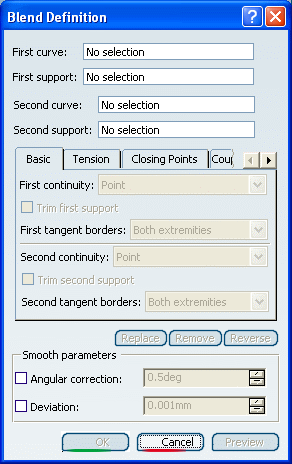
Successively select the first curve and its support, then
the second curve and its support. These can be surface edges, or any curve.
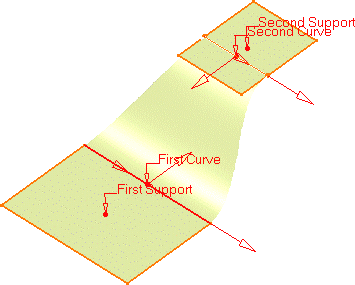
Set the continuity type using the Basic tab.
It defines the continuity connection between the
newly created surface and the curves on which it lies.
The illustration above, shows the Tangency
continuity, and the following illustrations show the Point
and Curvature continuity types:
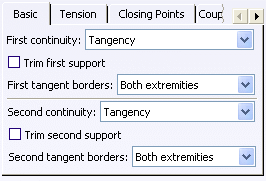
Point continuity on both limits
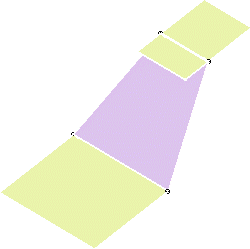
Curvature
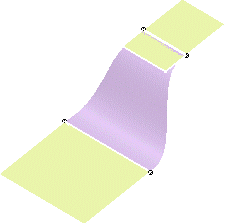
Select the Trim first support/Trim second support
check boxes,
on one or both support surfaces to trim them by the curve and assemble
them to the blend surface:
By default, the blend surface borders are tangent to the support
surface borders.
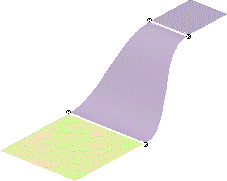
You can also specify whether and where the blend boundaries
must be tangent to the supports boundaries:
- Both extremities: the tangency constraint applies at
both ends of the curve
- None: the tangency constraint is disregarded
- Start extremity only: the tangency constraint applies at
the start endpoint of the curve only
- End extremity only: the tangency constraint applies at
the end endpoint of the curve only
The Start and End extremities are defined according to the arrows
in the blended surface's preview.
Set the tension type using the Tension tab.
It defines the tension of the blend at its limits. It can be
Constant or Linear, and can be set for each limit
independently. A third tension type is available:
S Type.
It enables to set a variable tension.
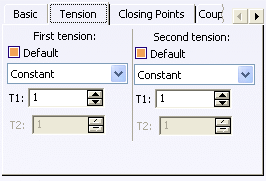
Click OK to create the blended
surface.
The surface (identified as Blend.xxx) is added to the
specification tree.

Create a Blend Between Closed Contours
You can create blend surface between closed contours.
Click Blend
 . .
The Blend Definition dialog box appears.
Successively select two contours.
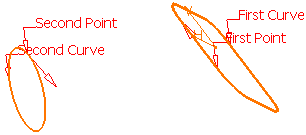
Click Preview.
The surface to be generated is twisted.
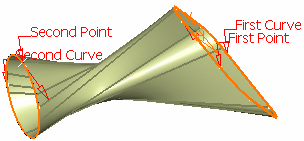
To avoid this you need to define a closing point.
In the Closing Points tab, use the
contextual menu and choose Create Projection on the First
closing point box.
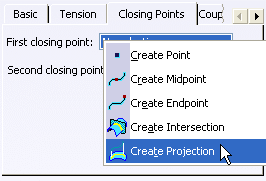
The Projection Definition dialog box appears.
Select the closing point on the second
contour, then the first curve onto which the point is to be projected. Click OK in the Projection Definition dialog box. Click OK in the Blend Definition
dialog box to create the blended surface.
The surface (identified as Blend.xxx) is added to the
specification tree.
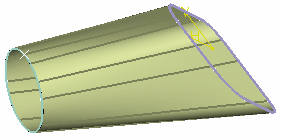

Create a Coupling Blend
You can create a blend surface between a coupling.
Click Blend
 . .
The Blend Definition dialog box appears.
Select the elements to be blended and click
Preview.
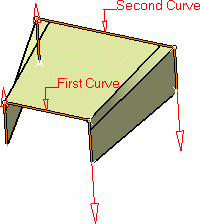
Select the Coupling / Spine tab
and define the coupling type.
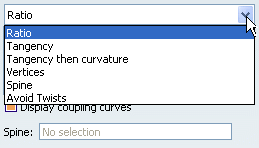
-
Ratio:
the curves are coupled according to the curvilinear abscissa ratio.
-
Tangency : the curves are coupled according to their tangency
discontinuity points. If they do not have the same number of
points, they cannot be coupled using this option.
-
Tangency then curvature: the curves are coupled according to
their tangency continuity first then curvature discontinuity
points. If they do not have the same number of points, they cannot
be coupled using this option.
-
Vertices: the curves are coupled according to their vertices.
If they do not have the same number of vertices, they cannot be
coupled using this option.
-
Spine: the curve are coupled
using a spine curve. This curve can either be a new curve or one of
the curves already specified. If no spine is explicitly selected, the
first curve is used as the default one.
Here is how the blended surface is computed using this coupling mode:
at any given point on the spine, a plane normal to the spine is first
computed then coupling points corresponding to the intersection of
this plane with the limit curves are computed. The blended surface
corresponds to the set of lines created with the coupled points. This
construction is similar to the one used when creating swept surfaces
using a linear profile and two guide curves.
In the Spine box, select the spine curve.
When using this option, the Display coupling curves option is
disabled and any manual coupling is removed.
-
Avoid Twists: The coupling points are automatically computed
hence avoiding possibilities of twisted geometry. When using this
option, the Display coupling curves option is disabled,
as well as the
manual coupling and developable modes.
Double-click in the coupling list or choose
Add in the contextual menu and manually select a point on the first
section.
The Coupling dialog box appears.
Select a corresponding coupling point on
each section.
The Coupling dialog box is updated consequently, and
the coupling curve is previewed, provided the Display coupling
curves option is active.
When a coupling point has been defined on each
section, this dialog box automatically disappears.
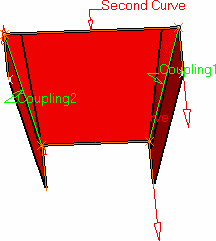
Click OK in the Blend Definition
dialog box to create the blended surface.
The surface (identified as Blend.xxx) is added to the
specification tree.
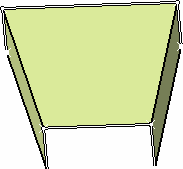

Create a Ruled Developable Surface
You can create a blend surface by defining the start and end connection points.
Click Blend
 . .
The Blend Definition dialog box appears.
Successively select the first
curve, then the second curve.
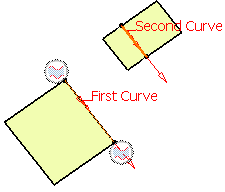
Select the Create a ruled
developable surface option under the Developable tab.
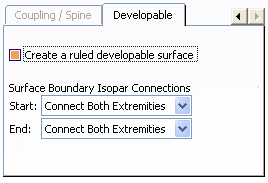
The Start
and End drop-down lists are enabled.
The options available under the Start drop-down list are:
-
Connect Both Extremities: to connect the extremities
of both curves
-
First Curve Origin: to free the first curve origin
-
Free Second Curve Origin: to free the second curve origin
The options available under the
End drop-down list are:
-
Connect Both Extremities: to connect the extremities
of both curves
-
First Curve End:
to free the first curve end
-
Free Second Curve End: to free the second curve
end
Click
Preview.
The maximum value of the Gaussian curve appears in the geometry
area.

Click
OK to generate
the ruled developed surface.
The surface
(identified as Blend.xxx) is added to the specification tree.

Define Smooth Parameters
You can define the smoothing parameters on the blend surface.

- In the Smooth parameters section, check:
- Angular Correction to smooth the blending motion along the reference guide curves. This may be necessary when small discontinuities are detected with regards to the spine tangency or the reference guide curves' normal. The smoothing is done for any discontinuity which angular deviation is smaller than the input value, and therefore helps generating better quality for the resulting blended surface. Over 0.01 degree, the smoothing is cancelled. By default, the angular correction is set to 0.5 degree.
- Deviation to smooth the blending motion by deviating from the guide curve(s). A smoothing is performed using correction default parameters in tangency and curvature. By default, the deviation is set to 0.001mm. Refer to General Settings for more information.
|
![]()
![]()

















